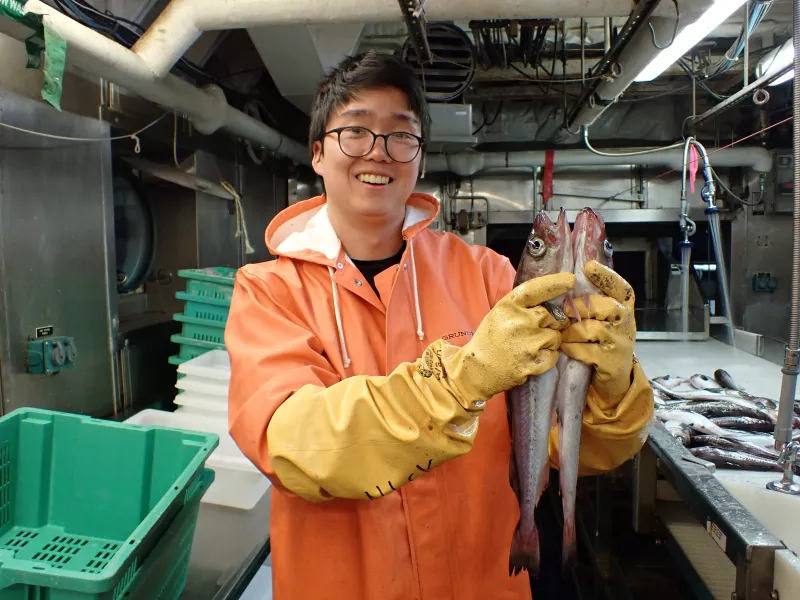This summer, high school teacher Nick Lee traveled more than 4,000 miles from his home in Boston to one of the country’s most remote locations: Dutch Harbor, Alaska. From there, he and the team of scientists aboard NOAA Ship Oscar Dyson sailed out into the eastern Bering Sea in search of walleye pollock. Embedded in the science crew, Nick worked regular shifts catching, sorting, measuring, and dissecting pollock—all the while blogging about his experience for his students.
Nick is the latest in a tradition of teachers traveling to this distant ocean frontier to help NOAA scientists study pollock in the eastern Bering Sea. Since 1994—30 years to the week, in fact, that Nick set sail—34 teachers from around the country have helped scientists collect data on this vital fishery. It’s one of the longest running collaborations between NOAA scientists and NOAA’s Teacher at Sea Program.
The teachers’ students may not recognize pollock by sight or name, but many have eaten it. It is, after all, a staple of cafeteria fish sticks and fast food fish sandwiches. Bering Sea pollock support one of the largest fisheries in our nation. Keeping tabs on their numbers is essential for setting sustainable catch limits.
To do this, NOAA Fisheries conducts multiple scientific surveys to collect data on eastern Bering Sea pollock and their environment. One of these, the biennial midwater acoustic-trawl survey, regularly hosts Teachers at Sea. Over a 3–4 week mission, teachers learn first-hand how scientists use acoustic technology and trawl catches to estimate the abundance of pollock in the water column. Like Nick, the teachers dive into the science, immerse themselves in the research methods, and return to their classrooms with new insights.
But in the past three decades that teachers have been tallying pollock, the Bering Sea ecosystem has been changing. Warming waters have caused reductions in sea ice and changes in the size of seasonal “cold pools.” These shifts led to a cascade of complex changes in plankton, jellyfish, and finfish distributions, including the collapse of the snow crab population.
Data from the midwater acoustic-trawl survey help scientists track these changes. The survey also collects data on physical ocean conditions, other midwater finfish, and krill—tiny crustaceans that serve as a crucial food source for young pollock.
Through their participation in this long-running survey, NOAA Teachers at Sea have shared with their students one chapter of the story of our seafood in a changing ocean. We dug through our archive to find snapshots of the teachers connected to this singular effort over the years. We invite you to check them out on our timeline.



